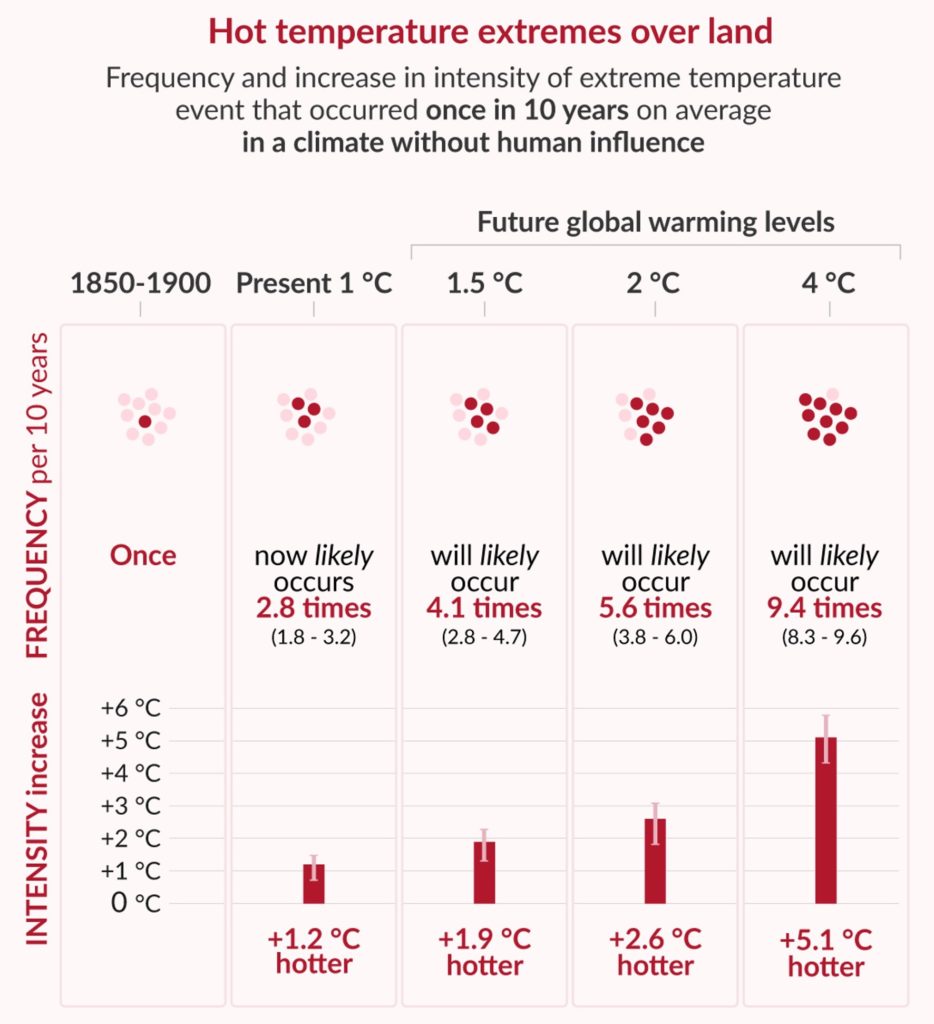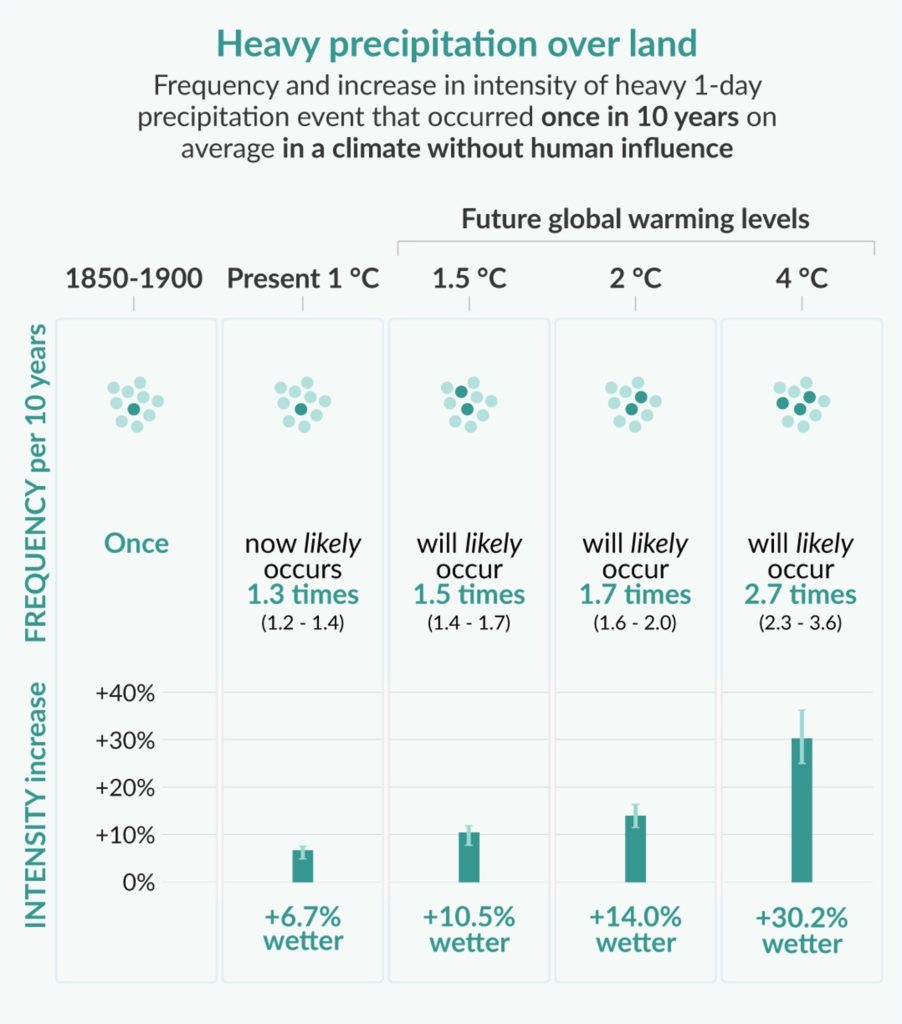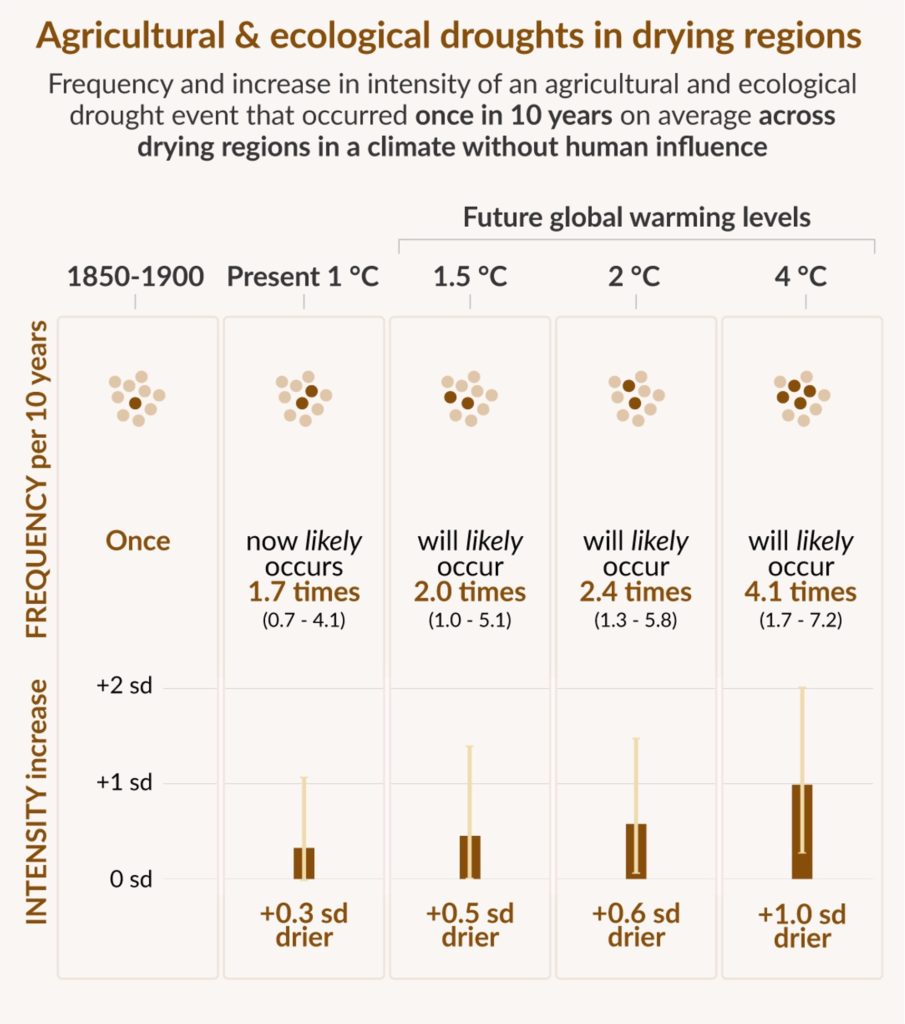Today, the Intergovernmental Panel on Climate Change (IPCC) released the first portion of its 6th Assessment Report (AR6) on climate change. Working Group I’s contribution focused on the current state of the climate, how human influence is changing it, and possible global pathways for the future. The report echoes the overwhelming scientific consensus that even the lowest emission scenario will expose communities across the globe to more extreme climatic events.
The IPCC Assessment Reports are globally recognised as the most comprehensive assessments on the state of climate science. The AR6 combines the scientific expertise of 721 authors from 90 different nationalities, including experts working in RECEIPT. That’s why we’re taking stock of the WG-I report published earlier today, diving into seven takeaways and their implications for decision-makers.
Takeaway 1 – Climate change is already going on everywhere
Although climate change is often combined with “future”, “threats” or “preparing”, climate change is happening now. We are currently at a global temperature 1.2°C above pre-industrial levels. As a result, climate change is already affecting every region in the world. From repeated heatwaves and droughts to disrupted rain patterns and wildfires, extreme events are no longer exceptional. What’s more, the report confirms that human influence is contributing to much of this extreme weather.
Takeaway 2 – This will continue
As the global temperature is rising, many of the changes in the climate system are set to become more prominent. Even an optimistic scenario of a 1.5°C global temperature increase would mean a higher frequency of extreme weather events. And for every 0.5°C of global warming, the intensity of temperature, precipitation and drought extremes will become more severe. This means higher temperature peaks, longer dry spells and more extreme rainfall. The report indicates that for many weather types the increases in extremes will be proportional to the global temperature increase. In some regions these increases in temperature can be up to 2-3 times the rate of global warming due to local feedbacks.
What the graphs below are telling us:
These three graphs represent the frequency and intensity of extreme temperatures, precipitation, and drought that happened on average once in a decade in the late nineteenth century*.
*Seen as a pre-industrial time, when human activities’ influence on the climate was not yet significant.
In the top charts, each coloured dot represents one year in a 10- year sample, with darker dots indicating years in which extreme events are likely to occur. As such, it shows how frequent these events would be.
The bottom charts show how much more intense these events would be, with the lighter-coloured stripe indicating a margin of error.
The warmer the earth gets, the more common and severe these events will become. Even if we can limit global warming to 1.5°C, heatwaves, floods, and droughts will become worse and more frequent.



These graphs were taken from the IPCC’s Summary for Policy Makers
Takeaway 3 – It’ll be more wet and more dry
As global surface temperatures increase, changes in the water cycle will intensify, increasingly disrupting rain patterns. The graph above shows that global warming will entail both extreme rainfall and extreme droughts. What is more, this effect will spread across larger regions, with an increasing area of land experiencing serious inconsistencies in rainfall. This means that more people’s homes will be at risk of flooding, while farmers globally will also face dire growing conditions more often.
RECEIPT researchers have been studying how changing rain patterns outside Europe can threaten European livelihoods. They found that drought will become increasingly problematic for crops that are imported to the EU. Today, around 1% of the EU’s agricultural imports are vulnerable to drought. By 2050, that number will be between 40 and 44%! These numbers show that extreme climate impacts are just around the corner and that rapid climate adaptation is essential. First, it is important to understand which crops are most vulnerable to drought, and how drought patterns will change. Read all about it here.
Takeaway 4 – Higher global sea levels
Climate change is already baked into our future. Even with a net halt in carbon emissions, the greenhouse effect will continue to make the global thermometer rise before it stabilises. Glaciers and ice sheets will continue to melt for at least several decades. This means that sea levels will continue to rise throughout the 21st century and beyond, changing coastlines and flooding entire regions. Sea levels are expected to remain elevated for thousands of years, transforming not only what continents looks like, but also deeply impacting international relations. Changing borders can come with land disputes and legal issues. Statuses of underwater territories need to be re-examined and human rights of the relocating populations can be threatened.
RECEIPT researchers are looking into how rising sea levels may affect the functioning of critical coastal infrastructures such as electricity networks, telecommunication systems and ports. In a warmer climate with higher sea levels, these infrastructures are more frequently threatened by major storm surges, hurricanes and floods. These impacts quickly trickle down to affecting households and companies, spreading through society. RECEIPT’s research on sea level rise and coastal infrastructure supports practitioners to take sound mitigation and adaptation decisions.
Takeaway 5 – Natural variability can lessen or worsen our impact
Climate change deniers often argue that the climate changes naturally as well, both globally and locally. While this is true, experts have long debunked the theory that human influence hasn’t played a role. If the global warming were only due to natural processes, we could not have reached the level of warming and records of extreme weather experienced over the past century.
Natural variability in climate processes and local feedbacks are intensify or obscure human-caused changes. In any given climate period at any location, natural variability can cause the climate to be different than its long-term trend. Some regions will experience temporary cooling despite the global mean temperature being on the rise due to human activities. Expected regional changes in the next decades depend on natural variability and on the uncertainty in detailed climate projections.
Takeaway 6 – Every region will experience overlapping climate effects
In the next 30 years, all regions in the world will experience further climate changes. What’s more, many regions will see an increase of multiple climate risks that coincide to create more harmful events. Higher temperatures combined with longer periods of drought can lead to worse forest fires and more failing crops than either heat or drought alone would cause. Some areas are more prone to such concurrent climate events than others. Take urban areas, for example. They are generally warmer than their surroundings since their concrete and glass surfaces trap heat. Concrete and paved areas also absorb less rainwater. Together, these differences can alter the urban water cycle, increasing rainfall and runoff intensity.
The combination of future urban development and escalating extreme climate events are drastically increasing the number of people at risk of extreme weather. Since 2008, three times more people had to leave their homes because of natural disasters than refugees from war or violence. RECEIPT researchers studied how climate change and the growing world population increase the number of people at risk of losing their homes. They found that the number of people at risk of having to relocate due to river floods is expected to double by 2100. That’s not only traumatic for citizens, but also explodes costs for public authorities and insurers.
Takeaway 7 – Low-likelihood, high-impact events will increase
As global warming increases, some events with historically low likelihood will become more frequent (as shown in the graph above). There is also a higher chance that compound events will have unprecedented impacts. By exploring possible low-likelihood, high-impact events, scientists can improve the pictures of complex, multi-facetted and cascading interactions. This is becoming an increasingly essential step in risk management and adaptation.
We shouldn’t wait for unforeseen disasters to happen to prepare for them. The IPCC refers to storylines as a tool to explore uncertainty in climate change and in natural climate variability. That’s why RECEIPT is creating future climate storylines, exploring the climate vulnerability of our systems. We are using downward counterfactuals that ask “what if”. They look at potential impacts of past events and what they would look like under warmer climate conditions. This can shed light on the weakest links in our systems. Knowing where the vulnerabilities are hidden is essential for policymakers and practitioners to take the necessary actions to adapt.
RECEIPT’s contribution to IPCC’s AR6
Several RECEIPT experts were involved in the IPCC’s Working Group I. Bart van den Hurk, the coordinator of our project, worked as a lead author on the Atlas chapter with regionalized maps of observed and projected climate change, a new feature of AR6. An Interactive Atlas was also released today and provides access to interactive regional climate change information. The assessments available in the Atlas will be published in the form of regional fact sheets that are downloadable here.
Suraje Dessai and Jana Sillmann, who are respectively leading RECEIPT’s work on hotspot search and storyline development, and on synthesising the synergy of risks and policy implications, are lead authors in WG-I’s assessment as well. They were involved in the work on climatic impact-drivers, elements and trends that influence the climate, either positively or negatively.
Reinhard Mechler serves as RECEIPT’s lead on financial impacts and is involved in IPCC’s Working Group II. He is lead author working on decision-making options for managing risk. The WG-II report will be published in March 2022.
So, what now?
The IPCC WG-I report is published just in time for the upcoming COP26 in Glasgow this November. The report shows that there is much work to be done to limit human impact on the climate. And that governments need to act urgently. They need to limit further warming and prepare to face the consequences of the changes that are already in motion.
The COP26 is an opportunity for world leaders to take bold action, to enact new ambitious policies that will enhance global resilience to the challenges ahead.
In 2022, the IPCC will release two more assessment reports. Working Group II is working on society and nature’s past and future vulnerabilities to climate change and options for adaptation. Working Group III focuses on the range of mitigation options and solution pathways. RECEIPT is proud to have its experts contribute to this crucial assessment, carrying out research to help decision-makers better face vulnerabilities to climate change.
Read the report published earlier today on the IPCC website.
Published on : 05 August 2021
